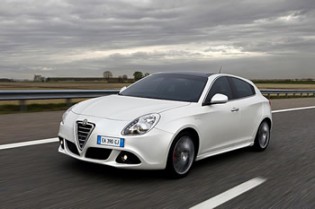Alpha Romeo brings back memories
A number of vehicle models have graced our roads over the years and while some of them are still very much around others have disappeared overtime only to reappear.
One such model is the Alpha brand by Italian car maker Alpha Romeo. For most Zimbabweans the name Alpha Romeo conjures up images of the Alphasud and Alpha Romeo Giulietta which were a common feature on our roads in the 1980s.

The original Giulietta engine produced a power output of 62hp (46 kW) in the sedan and 80hp (60 kW) in the Giulietta Sprint. The new Giulietta (right) undercuts its key rivals on price, its value for money. Average fuel economy and carbon emissions are also competitive no matter which version you choose
Today some of these makes are back on our roads in new improved shapes and sizes thanks to decades of creative workmanship by the Alpha Romeo team.
I want to take you back in time to the origins of the Alpha Romeo brand and run through the products that the car makers has produced and the transformation in the makes to the present day.
According to Wikipedia Alfa Romeo Automobiles was founded as A.L.F.A. (Anonima Lombarda Fabbrica Automobili) on June 24, 1910, in Milan.
The company started by producing racing cars in 1911 and has been in car racing since. It has since built a reputation for building expensive sport cars.
Its first product was the Alfa Romeo Giulietta, a compact automobile manufactured between 1954 and 1965.
The Giulietta was introduced at the Turin Motor Show in 1954 and almost 132 000 were built in the Portello factory in Milan. The first Giulietta model was a coupé, the Giulietta Sprint, that was introduced in late 1954.
This was followed by a sedan in spring of 1955 and in mid 1955, the open two-seat Giulietta Spider, featuring convertible bodywork by Pininfarina.
In 1957 more powerful Berlina version, called Giulietta TI (Turismo Internazionale) was presented with minor cosmetic changes to the hood, the dial lights and rear lamps.
Carrozzeria Colli also made the Giulietta station wagon variant called Giulietta Promiscua. Ninety one examples of this version were built.
A new version of the Giulietta debuted at the Frankfurt Motor Show in 1959.
The fuel tank was now incorporated in the right rear fender and was equipped with a door.
The nose was redefined with more rounded wings, recessed lights, new headlights and grille rings revised with horizontal bars.
The interior was much more organised and the dashboard instruments had an elongated bore including the tachometer.
The series number was changed from 750/753 to the 101 series. In 1961, the TI version was upgraded to 74PS (54 kW).
With this new engine the car could reach a speed of almost 160 km/h.
Production of the standard Berlina continued until 1963, while that of the TI continued for one more year.
The Giulietta used an Alfa Romeo Twin Cam engine 1290cc straight-4, with a light alloy cylinder block and an alloy cylinder head with twin overhead camshafts.
The original Giulietta engine produced a power output of 62hp (46 kW) in the sedan and 80hp (60 kW) in the Giulietta Sprint.
This was to be increased to 100 hp (75kW) in later sporting models such as the Giulietta Sprint Speciale and the Giulietta Sprint Zagato 1,3 litre engine had 74mm bore and 75mm stroke.
Today, the Giulietta has a wide range of engines, all of which are turbocharged, and even the least powerful ones gives out a decent performance.
Those that prefer the petrol engines can choose from 1,4 litres with either 118-or 168 break horsepower (bhp), which is a measure of the power (energy over time) that your engine can apply through the wheels of the car, or a 231bhp 1,7 litre unit that is fast enough to frighten all but the hottest hatches.
The diesel engines range from 1,6 litre 103bhp units to a couple of 2,0 litre units, with either 138 or 168bhp.
The 2,0 litre versions are fast, but the 1,6 is flexible enough that you don’t need to spend the extra.
The Giulietta’s throttle and steering responses can be altered by selecting between three modes.
Whichever you choose, you don’t get much steering feel, though and you’ll want to avoid the dynamic mode in town because the throttle is so sensitive that it’s hard to drive the car smoothly.
The ride is decidedly clunky, too, but the Giulietta’s decent body control makes it feel reasonably nimble in bends. The petrol engines are smooth when you want them to be and have an appealing growl when you work them hard.
The smaller diesel engines are also pretty good, but the 2 litre is grumbles and whooshes loudly under acceleration. The manual gear-shift is quite notchy. However, the TCT twin-clutch gearbox is smooth.
The Giulietta undercuts its key rivals on price and although you won’t get a huge dealer discount, its value for money.
Average fuel economy and carbon emissions are also competitive no matter which version you choose.
The Giulietta looks classy on the outside, but its cabin is a little disappointing because the materials in the lower reaches are pretty hard and scratchy. What’s more, the metallic highlights on its centre console are disappointingly plastic and the indicator and wiper stalks feel a bit lightweight. Alfa’s reliability record isn’t the best either.
However, stability control, front, side and curtain air-bags and active anti-whiplash front head restraints are all fitted as standard.
What’s more, the Giulietta was awarded one of the best ever scores in Euro NCAP crash tests.
Deadlocks and marked parts are also found on every version, while Lusso models and above come with an alarm.
The Giulietta’s pedals are all at different heights, which means it’s more difficult than it should be to move from one to another, while the clutch is very close to the centre console, so you can’t rest your left foot.
To make matters worse, the seats don’t hold you in place particularly well and the steering wheel is too high, even when it’s in its lowest setting.
At least the dashboard controls are simple.
The Giulietta is longer than VW Golf, but although there’s plenty of space upfront, rear head and knee room are below average for the class.
The door pockets are also pretty small, but there’s some useful oddment storage between the front seats.
The boot is no better than reasonable for size, and there’s a high lip to load items over.
There are four Giulietta trims. Entry-level Turismo cars come with air-conditioning, front and rear electric windows and an engine stop-start system, but you need to upgrade to Lusso spec to get alloy wheels, steering wheel-mounted stereo controls and Bluetooth.
Veloce models bring sports suspension and sportier trim, while the flagship Cloverleaf has an even sportier suspension set-up and a host of cosmetic upgrades.
For what’s available in Zimbabwe, please visit the Zimoco Dealership for engine specifications and actual pricing.
Till next week, stay blessed and be safe.
- For feedback e-mail [email protected] or on facebook torque with Fact Jeke










Comments